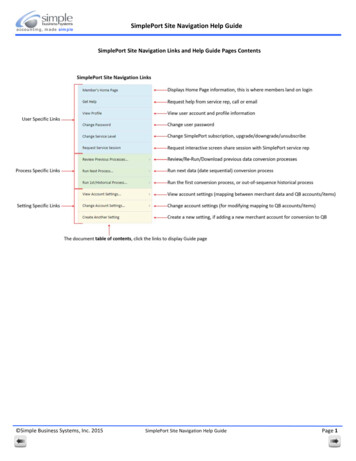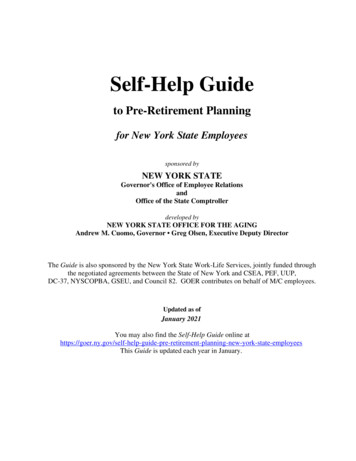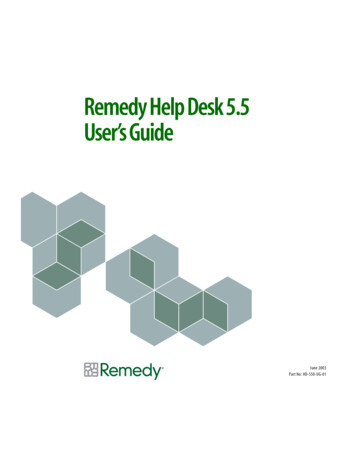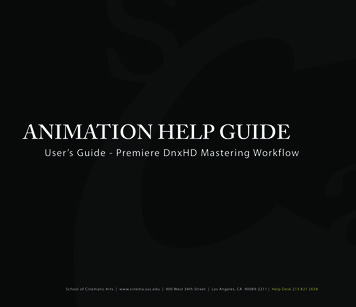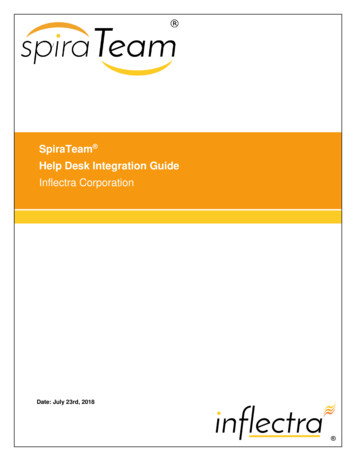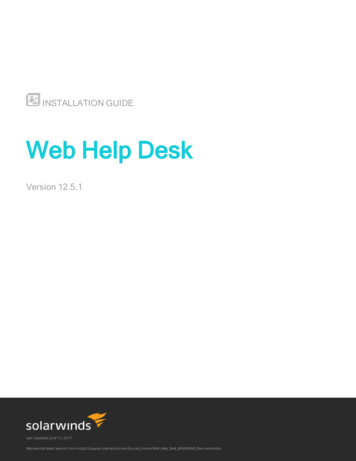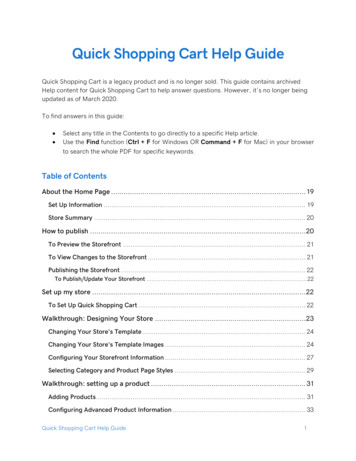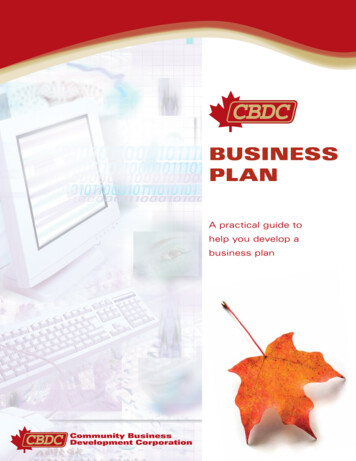
Transcription
BUSINESSPLANA practical guide tohelp you develop abusiness plan
This document is also available in French
Getting Started2 Studying the Market3 Planning a Business4 The Business Plan5-Introduction6-Ownership and Management7-Financial8-Market Summary10-Personnel Requirements12-Forecast Assumptions13-Cash Flow for 12-month period14-Financial Statements16-List of Existing & Proposed Machinery,Equipment, Fixtures & Furnishings /Relating to Proposed Project22-Security Offer23-Environmental Questionnaire24-Summary of the CBDC Privacy Policy25-Authorization for Credit Information29-Personal Balance Sheet /Application For FinancingNeed assistance call 1-888-303-2232ContentsTable of ContentsCBDC Business PlanI1
Getting StartedThere are many ways to start a small business but each approachshares common elements you need to consider.TimeEnjoymentHow much time do you have to develop yourbusiness idea? By allowing yourself enough time,you will likely avoid mistakes that could provecostly.Will you enjoy the business? This is a majorconsideration, especially since owning a smallbusiness is often difficult and involves longhours. There will be challenges and roughspots. You will need substantial commitmentand self-sacrifice in the months that lie ahead.MoneyHow much money is at your disposal? Mostentrepreneurs discover their businesses requiremore capital than originally anticipated. Theneed for adequate financing varies from businessto business. You should ensure that you haveaccess to enough money to allow for all possiblecontingencies so that you don’t have cash flowproblems or miss opportunities.ExpertiseDo you have the knowledge and skills required tomake a success of this business? If not, it may beworthwhile to take some courses or work in theindustry until you gain the knowledge you need.Risk ToleranceHow much risk is involved? You need to honestlyassess your personality and finances to determinehow much risk you can tolerate. This may rule outsome high-risk opportunities.Financial ReturnCan you make a living from this business? Somepeople go into business without a clear idea of justhow profitable the venture will be. Take the time todetermine if your business revenues will justify youreffort and provide you with the income you need.2ICBDC Business PlanFamily ConsiderationsWill this new business adversely affect yourfamily? Substantial sacrifices in time and moneyare required in the early stages of any business.You need to determine whether your savings orprofits from the business will provide you andyour family with an adequate standard of livingespecially in the early stages of the business.You will also need to find out how committedyour family is to the business. For example,will they be able to cope with the extra hoursneeded to get a small business up and running?Professional GuidanceFinally, getting started means starting out right.It is important to realize before you start out thatthere are many important decisions to be madeinvolving legal and taxation issues, insurance,finance, bookkeeping and accounting, hiringemployees, etc. These can often be complicatedand difficult to address without specializedexpertise. Consequently, you should consultprofessionals such as: lawyers, accountants,insurance brokers, professional or accreditedfinancial planners, bankers and governmentagents to get the best possible advice and toavoid mistakes that may come back to hauntyou later on.www.cbdc.ca
StudyingStudying the MarketThe first thing you need to do when thinking about starting a new business is todetermine whether you can make a success of it. This means asking tough questions about the potential demand for your products, how much you can chargeand whether payback will be sufficient to make it worth your while.This information is provided by a marketing plan.Although each marketing study is differentbecause every business is different, most seekto answer the following questions: What is the market potential for myproduct or service? Who will my customers be? How manyunits can I sell? How much can I charge? Who will my suppliers be and howmuch will they charge? What creditterms are they likely to offer? Who are my competitors and whatcompetitive advantages do I possess? How will I get my goods to market andhow expensive will this be? Will this business produce a largeenough profit to justify the sacrificeswhich will be required?Many publications and databases can help youassess the potential of industries and markets.(A visit to your local CBDC is a good first step ingetting this information).These plans are dynamic and are only helpful ifthey change as your business changes. Ratherthan prepare a marketing plan and file it awayin your desk drawer, you should re-examineyour plan from time to time in the light of newdevelopments and make the necessary changes.Your marketing plan will then guide and supportyour efforts on a continual basis.Armed with answers to these questions anda properly laid out marketing plan, you willbe in a much better position to determine theviability of your idea.Getting the information for such a plan isoften quite easy. For instance, one possibletechnique is to interview potential customersor those already in the industry. Trade andindustry associations can also be helpful sincethey possess in-depth information about theirindustries.Need assistance call 1-888-303-2232CBDC Business PlanI3
PlanningPlanning a BusinessOnce you have completed your marketing study, you can use it as the startingpoint for developing one of the most important foundations of any business - thebusiness plan.Business plans contribute to the future success ofa business in several ways. They are necessarywhen seeking loans; they help you measureprogress; and they tell you where you are goingand how to get there.A business plan usually includes a descriptionof your business and the industry in which itwill function including suppliers, customers andcompetitors, the products and services you willprovide, your price schedules, sales, and yourmarketing and production plans.government departments or professionalssuch as a lawyer or accountant.Business planning is a continuous process. Nobusiness stays the same for long. Therefore,you need to revise your plan periodically toallow for changing circumstances. This willlet your business plan continue to work foryou. The process of rethinking the plan willforce you to develop new ways of looking atyour business and its environment. This mayprovide you with new ways of increasingrevenues or cutting costs.You will also need to outline the opportunitiesand threats facing your business, the resourcesyou will require, your expansion plans, andcurrent and projected financial statements.Planning for the FuturePlanning is critical, not only in the early stagesof business, but also as your business startsto grow. Continuous planning is necessary tohelp you avoid some of the pitfalls which oftenaccompany expansion.One plan you must consider is human resourceplanning - the hiring and management ofemployees. You need to consider how you willfind employees with the skills and trainingneeded to make your business a success.You need to be aware of the many legal,regulatory and tax requirements related to havingemployees on your payroll. Some of thesefall under provincial jurisdiction and includeemployment standards, minimum wages,workers’ compensation, and occupational healthand safety.Others fall under federal jurisdiction and includeEmployment Insurance, Canada Pension Plan andIncome Tax. For further information, you shouldcontact the appropriate provincial and federal4ICBDC Business Planwww.cbdc.ca
The Business Plan
Business PlanA.Introduction1. Name of Company: Contact Number:Name of Applicant:(Please provide photo identification with your application)2. Is this a new or existing business? New Existing Date business established:3. Type of Operation: Manufacturing Wholesale/Retail Agriculture Construction Aquaculture / Fishing Transportation Forestry Mining Tourism Other (Specify)4. Mailing Address:Postal Code:5. Telephone Numbers:Residence: Cell:Fax: E-mail:6. Proposed location of business:7. Legal Form of Business: Incorporated Sole Proprietorship Partnership Co-operative To be incorporated8. Date Incorporated:6ICBDC Business Planwww.cbdc.ca
B.Ownership and Management1. List of Directors/Shareholders/Key Staff: (Please attach detailed resumes)NamePositionYears in BusinessShares Held (%)2. Explain the duties and responsibilities of management and key staff.C.Financial / Legal / Technical1.(a) BankerLine of Credit Phone Number:(b) Accountant(c) Legal Advisor(d) Insurance Co. / Agent(e) Fiscal Year EndD.1.Name:Project DescriptionBriefly describe your business:Need assistance call 1-888-303-2232CBDC Business PlanI7
2. List the estimated dates for the acquisition of equipment, inventory, staffing, financing, andother items needed before you can commence your project.ItemEstimated date of acquisitionDate construction will begin:Date operations will commence:E. Financial1. Use of Funds:Source of Funds:Land CBDC Building Bank/ Credit Union Equipment Provincial Government Vehicles BDC Leasehold Improvements ACOA Inventory Other: Working Capital Other: Miscellaneous Owner’s Contribution Total Total Have you ever applied for or received previous assistance from the Federal or the Provincialgovernment? If yes, please describe.2. Have any of the assets contributed been pledged as security? Yes NoIf yes, to whom? For what purpose?8ICBDC Business Planwww.cbdc.ca
3. Will any part of the owner’s contribution be borrowed? Yes NoIf yes, from whom?Security given:Terms: Interest Rate:4. Please answer the following questionsa. Have you ever been or are you in the process of applying for protection under theBankruptcy Act? Yes Nob. Have you ever been sued or been the subject of an originating notice? Yes Noc. Are you presently the Guarantor for any loan? Yes Nod. Are you or the business in tax arrears to CRA? (HST and Source Deductions) Yes NoIf you answered yes to any of the above, please provide details in the space provided5. Provide quotations for the purchase price of any assets being considered as part of thisfinancing request.Need assistance call 1-888-303-2232CBDC Business PlanI9
F. Market Summary1. Product / ServiceApplicants should list each service if more than one is provided. Provide as much detail aspossible about the service. If a similar service exists in your trading area, describe anyadvantages your business may have (i.e. pricing, supply of raw materials, transportation, etc).2. Is your business seasonal? Yes No3. Hours of Operation:4. Will the business be extending credit? At what terms?5. Typical CustomersWho are your customers?AgeSexIncome LevelWill your clients be other businesses or the general public? If other businesses, name them. Doyou have letters of intent? (Provide letters of intent where possible.)10ICBDC Business Planwww.cbdc.ca
6. Trading AreaWill all your business be generated within your local community or will your business drawcustomers from surrounding communities? Explain7. Existing Business CompetitionWho are your competitors, where are they located, and how long have they been in business?Strengths and Weaknesses?8. Market JustificationWhy do you feel the identified trading area can support your proposed project?9. Advertising / PromotionHow do you propose to advertise your product/service? Identify the cost of doing so.10. Basis of projectionWas this market information obtained from a similar type of operation, or on the basis ofindustry norms, or some other method? Explain.Need assistance call 1-888-303-2232CBDC Business PlanI 11
G. Personnel Requirements1. List details of new employment to be created. Full Time Part Time Seasonal2. If this is an existing business please list the details of existing employment. Full-time Part-time3. ManagementIdentify the specific duties of key management personnel with regards to areas such assales, marketing, bookkeeping, etc. List any previous experience which may be beneficial tothis business.IMPORTANT: Have you received the necessary permits or reviewed your submission with theappropriate regulatory agency(i.e. Department of Health, Fire Marshal, Municipal DevelopmentDepartment, Social Services, Forestry, Fisheries, Environment, Tourism, etc.)? Please provide copiesof any permits required.H. Financial Information (to be attached)1. Historical Financial Statements:Enclose statement for the last three years of operation2. Pro-Forma Financial Statements:a.Balance Sheet – Yearly for two yearsb.Income Statement – Yearly for two yearsc.Statement of Cash Flow – Projected on a monthly basis for the1st two years of operations12d.Sales necessary to break-evene.If sole proprietor please include your personal income tax notice of assessment forthe past three yearsICBDC Business Planwww.cbdc.ca
I. Forecast AssumptionsSales: (Explain how you arrived at sales figures: i.e. percentage of total market, number of unitssold, selling price, sales by unit of time – week, month, year, etc.)Material Costs: (Related directly to number of units sold)Salaries / Wages and Benefits: (Please list owner’s salary/wage separately)Other expenses: (State the basis for amounts shown in each of these expense categories andwhether they are estimates or quoted costs. Ensure your interest and bank charges reflect theproposed debt included in your loan application.)Other income: (Clearly explain any items in this area and state whether they are extraordinary orongoing.)Drawings / Taxes: (If the business is not incorporated, ensure you include the total amount of cashwithdrawals by the proprietor or all partners. Also a
let your business plan continue to work for you. The process of rethinking the plan will force you to develop new ways of looking at your business and its environment. This may provide you with new ways of increasing revenues or cutting costs. Planning a Business Once you have completed your marketing study, you can use it as the starting point for developing one of the most important .


